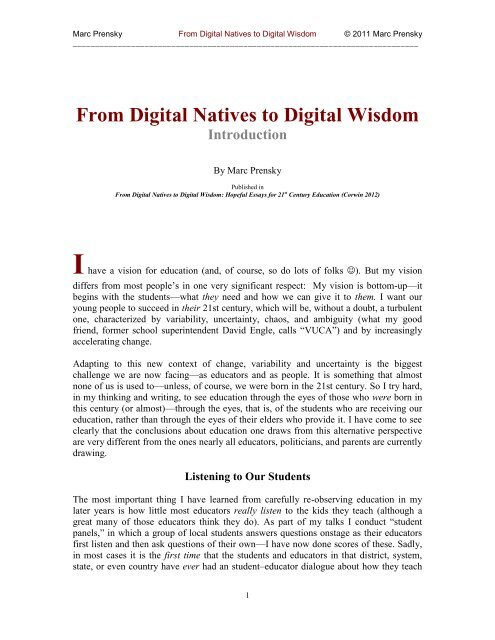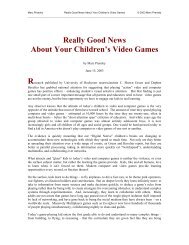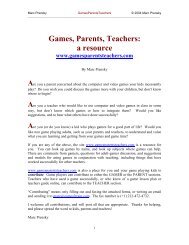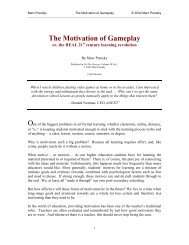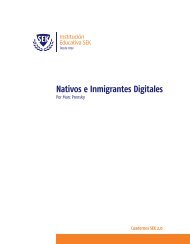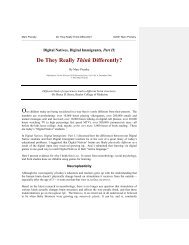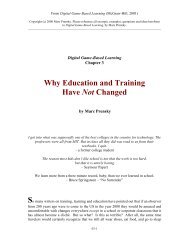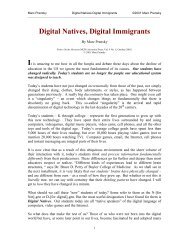Digital Wisdom - Marc Prensky
Digital Wisdom - Marc Prensky
Digital Wisdom - Marc Prensky
You also want an ePaper? Increase the reach of your titles
YUMPU automatically turns print PDFs into web optimized ePapers that Google loves.
<strong>Marc</strong> <strong>Prensky</strong> From <strong>Digital</strong> Natives to <strong>Digital</strong> <strong>Wisdom</strong> © 2011 <strong>Marc</strong> <strong>Prensky</strong><br />
_____________________________________________________________________________<br />
From <strong>Digital</strong> Natives to <strong>Digital</strong> <strong>Wisdom</strong><br />
Introduction<br />
By <strong>Marc</strong> <strong>Prensky</strong><br />
Published in<br />
From <strong>Digital</strong> Natives to <strong>Digital</strong> <strong>Wisdom</strong>: Hopeful Essays for 21 st Century Education (Corwin 2012)<br />
I have a vision for education (and, of course, so do lots of folks ). But my vision<br />
differs from most people’s in one very significant respect: My vision is bottom-up—it<br />
begins with the students—what they need and how we can give it to them. I want our<br />
young people to succeed in their 21st century, which will be, without a doubt, a turbulent<br />
one, characterized by variability, uncertainty, chaos, and ambiguity (what my good<br />
friend, former school superintendent David Engle, calls “VUCA”) and by increasingly<br />
accelerating change.<br />
Adapting to this new context of change, variability and uncertainty is the biggest<br />
challenge we are now facing—as educators and as people. It is something that almost<br />
none of us is used to—unless, of course, we were born in the 21st century. So I try hard,<br />
in my thinking and writing, to see education through the eyes of those who were born in<br />
this century (or almost)—through the eyes, that is, of the students who are receiving our<br />
education, rather than through the eyes of their elders who provide it. I have come to see<br />
clearly that the conclusions about education one draws from this alternative perspective<br />
are very different from the ones nearly all educators, politicians, and parents are currently<br />
drawing.<br />
Listening to Our Students<br />
The most important thing I have learned from carefully re-observing education in my<br />
later years is how little most educators really listen to the kids they teach (although a<br />
great many of those educators think they do). As part of my talks I conduct “student<br />
panels,” in which a group of local students answers questions onstage as their educators<br />
first listen and then ask questions of their own—I have now done scores of these. Sadly,<br />
in most cases it is the first time that the students and educators in that district, system,<br />
state, or even country have ever had an student–educator dialogue about how they teach<br />
1
<strong>Marc</strong> <strong>Prensky</strong> From <strong>Digital</strong> Natives to <strong>Digital</strong> <strong>Wisdom</strong> © 2011 <strong>Marc</strong> <strong>Prensky</strong><br />
_____________________________________________________________________________<br />
and how their kids want to learn (as opposed to about specific details and grades).<br />
I believe strongly that if we did listen to our students’ opinions on this, and did have such<br />
dialogues universally—and, more importantly, if we acted on what we heard—we would<br />
do things very differently. Not that our young people have all the answers—they don’t.<br />
But they do have the educational needs. We adults have educational needs, too, but a very<br />
different set. Adults have needs such as being able to demonstrate “educational<br />
effectiveness” (that is, that we are “getting the kids up to grade”) and “keeping our<br />
country competitive.” (Actually, many of what adults call “educational needs” are far<br />
more about the adults than about the kids.) The kids just need and want the skills and<br />
tools to succeed in their own times and lives.<br />
To the disappointment of some (and the delight of many), the vision I have is not just<br />
about technology in education. In fact, it is not even just a vision of better education. My<br />
vision is one of better people, better equipped to face the challenges of the world they<br />
will live in—that is, a world far different than yesterday’s or even today’s. Technology<br />
has an important place in that vision, because it has an important place in our future. But<br />
it does not dominate the vision; rather it supports it. As one of my student panelists put it<br />
brilliantly: “We see technology as a foundation. It underlies everything we do.” In the<br />
end, I am far more interested in creating important, useful learning and life opportunities<br />
for our students than I am in promoting any educational technology. (Except, of course,<br />
when technology helps achieve those things.)<br />
Inspiring Teachers<br />
A key element of realizing and implementing my vision has become—increasingly—<br />
inspiring and motivating teachers. Although I believe that all adults should play a role in<br />
educating our youth, the greatest hope for the 55 million kids in America (and the<br />
billion+ kids in the world) lies with the people with whom they spend a great many of<br />
their most formative years. What our teachers offer our students—that is, how teachers<br />
view their students and how they see their mission with them—will have an enormous<br />
influence on the world to come. Despite what some critics may wish for, we are not going<br />
to suddenly recruit and retain a “better” group of teachers—we have, in the main, a group<br />
of highly dedicated people who have chosen education as their life’s work. My goal is not<br />
to waste or destroy this precious resource but to support it and make the most of it.<br />
Most of our teachers need neither punishment nor replacement, but rather new<br />
perspectives and ideas that work. Our educational context has changed, and a new<br />
context demands new thinking. This is what I try to provide.<br />
It is critical, though, to understand that because the locus of “knowledge” has, in the 21st<br />
century, moved to a great extent from the teacher to the Internet, and because the<br />
personal passions of our 21st century students have become the kids’ best (and often their<br />
only) motivation to learn, our teachers’ job—in fact their very raison’d’être—is going<br />
through enormous change. Rather than trying to insert knowledge into our kids’ heads, as<br />
2
<strong>Marc</strong> <strong>Prensky</strong> From <strong>Digital</strong> Natives to <strong>Digital</strong> <strong>Wisdom</strong> © 2011 <strong>Marc</strong> <strong>Prensky</strong><br />
_____________________________________________________________________________<br />
in the past (and then to measure how much of it got there), today’s teachers need to find<br />
ways to create 21st century citizens (and workers) who parrot less and think more. This<br />
requires fully integrating into our teaching “meta” skills like critical thinking, problem<br />
solving, video and programming, just as we now integrate reading and writing. To make<br />
this happen, teachers and students will need to work together in new forms of<br />
“partnering” in which students do what they do best—for example, use technology, find<br />
information, and create products that demonstrate their understanding—and in which<br />
teachers guide students by doing what they do best—for example, ask the right questions,<br />
put things into the proper context, and ensure quality and rigor.<br />
Moving their practice into the new context for education can be—and is—exhilarating for<br />
most teachers. But it is also challenging.<br />
Some protest that they are prevented from doing what they want to do, and know they<br />
should do, by the current atmosphere of proscribed curriculum and testing. I agree that<br />
this atmosphere is not helpful. Yet I believe strongly that there are ways to accommodate<br />
those requirements and still teach in a way that motivates our students to prepare<br />
themselves for the future. In fact, our success at doing this will be the strongest argument<br />
for removing those unhelpful barriers.<br />
I truly believe that when most teachers understand that the new context is the cause of our<br />
educational problems—and that that is why many of their old practices no longer work as<br />
expected—they will figure out what to do differently. This is particularly true, I have<br />
seen, if they are offered good examples and suggestions. What our teachers need is the<br />
freedom to implement what they know to be right.<br />
Certainly, the results of teaching in a modern way that connects with 21st century<br />
students can excite and stimulate educators. I receive many emails from teachers who<br />
have come away from my talks and writings newly energized and exhilarated. Many now<br />
say, as one teacher nicely put it, that “I used to teach my subject. Now I teach my<br />
students.” Several have expressed that my ideas, particularly around connecting more<br />
deeply with students, have brought them back to the reasons they went into teaching in<br />
the first place. I am thrilled to find this happening.<br />
I firmly believe that the new teaching roles that the 21st century offers are so much<br />
better, so much more powerful, and so much more interesting than what came before, that<br />
most teachers will, once they get their heads around those roles, rush to embrace them.<br />
Not Easy<br />
But getting one’s head around new roles and approaches is not always easy. Change is<br />
difficult for all of us, particularly those not used to it. As psychologist Ron Evans points<br />
out, change involves not only learning new perspectives and behaviors but also grieving<br />
and mourning for those things we liked, found valuable, and were good at that no longer<br />
work (lecturing, for example). I believe, in fact, that what teachers need to do is best<br />
3
<strong>Marc</strong> <strong>Prensky</strong> From <strong>Digital</strong> Natives to <strong>Digital</strong> <strong>Wisdom</strong> © 2011 <strong>Marc</strong> <strong>Prensky</strong><br />
_____________________________________________________________________________<br />
described not as "changing," but rather as "adapting" to the new context and environment<br />
we all find ourselves in. And I believe that to adapt most quickly and easily, teachers<br />
must search continually for the types of “easy-to-do/high-impact” steps I describe in the<br />
essay “Simple Changes to Current Practices May Save Our Schools.”<br />
Yet even as teachers become motivated to adapt and move forward, it is not always<br />
obvious how to change old habits. So this is an area where I try to provide help as well.<br />
For example, I have found that some of our best models of how to teach already exist in<br />
many of our classrooms. Good elementary teachers, good music and art teachers (and our<br />
best teachers in general) rarely lecture; they almost always let their students create “by<br />
and for themselves” with the teacher’s guidance. We need to study and follow their<br />
prescient example.<br />
All 21st century teachers must deal with the difficult issue that much of what educators<br />
thought was important in the past—and therefore put in place as things for young people<br />
to learn—has changed, and, in many cases, lost its value. Our kids certainly feel this, and<br />
so do more and more of today’s instructors.<br />
So as I progress and learn, I search for more and better ways to give teachers guidance—<br />
goals to reach for and paths to follow to reach them. My strong belief is that once<br />
teachers understand the new goals for our students, many—hopefully most—will, as they<br />
should, invent their own paths to reach them. “Just tell me where you want me to go, and<br />
let me get there in my own way” is something that I hear frequently not just from<br />
students but from teachers as well. Just as with students, some teachers require more help<br />
(“scaffolding” in schoolese) than others until they can do it on their own, so I try to offer<br />
this as well.<br />
My main tool for encouraging adaptation is my writing. So I am extremely pleased to<br />
find this book in your hands, your mind open, hopefully, to the ideas it contains.<br />
In these essays I write about what I think needs to be done to improve our kids’<br />
education. I try to say this in as straightforward and jargon-free way as possible, so that<br />
everyone—teachers, parents, politicians, and others—can understand my meaning, and, I<br />
hope, be inspired to make positive changes based on my ideas. I search for memorable<br />
words and phrases that will help motivate readers to put an end to our old education that<br />
no longer works, replacing it with something far, far better.<br />
At the very center of this shift stand our teachers. This is because the true changes we<br />
need will not come from tweaking or changing “the system” (although in some cases that<br />
may help). The real changes our kids require will only come, in America and the world,<br />
from what every teacher does differently in every classroom,.<br />
Thinking Long Term<br />
This book unites many of the ideas I consider my most important. It includes my thoughts<br />
on the changing context of education and on what that implies about changing how we<br />
4
<strong>Marc</strong> <strong>Prensky</strong> From <strong>Digital</strong> Natives to <strong>Digital</strong> <strong>Wisdom</strong> © 2011 <strong>Marc</strong> <strong>Prensky</strong><br />
_____________________________________________________________________________<br />
teach, and what we teach. My essays are intended to help people—not just teachers, all<br />
people—see education from a different perspective—I hope a more useful perspective—<br />
and, from that new perspective, to arrive on their own at new insights and ideas about<br />
what to do differently.<br />
Whenever possible, I try to write (and think) about education for the long term. Although<br />
it is important, and often useful, to talk about what is currently going on, I realize that<br />
some of the things I talk about—specific technologies and products, for example—will<br />
soon be superseded (if they haven’t been already), and that some of the seemingly urgent<br />
educational conflicts of the moment will go away. I try, therefore, as much as possible, to<br />
put forth educational ideas that I hope will last. I am honored that the terms “<strong>Digital</strong><br />
Natives” and “<strong>Digital</strong> Immigrants” are still capturing people’s attention—drawing both<br />
praise and criticism—more than a decade after I coined them (“<strong>Digital</strong> Natives, <strong>Digital</strong><br />
Immigrants: Parts I and II”). In what I consider a huge compliment, someone recently<br />
emailed me that my piece about learning (“On Learning”) “held up well” after nine<br />
years—an eternity in these times of change.<br />
Some General Observations<br />
As I have traveled and talked with hundreds of students and educators, certain “big” ideas<br />
have come into more and more focus for me and have taken a larger place in my writing.<br />
For example:<br />
Talking with students in the United States and around the world<br />
exposed me to how little students’ opinions are listened to and taken<br />
into account. So I often now write in their defense (for example, “To<br />
Educate We Must Listen”).<br />
Closely observing young peoples’ game playing and other habits<br />
convinced me that what is taking place in education is not a “dumbing<br />
down” of this generation but rather a huge, continuous change to new<br />
and different things becoming important. I often publicly debate this<br />
with Mark Bauerlein, the author of The Dumbest Generation (a title,<br />
and term, that I find particularly disrespectful).<br />
Looking closely at how today’s students learn led me to the unexpected<br />
observation that the very process of learning—the crux of what we are<br />
all about as educators—is still very poorly understood. I found that<br />
what people think we “know” about learning is based on a huge<br />
variety of often conflicting theories, many of which apply more to<br />
groups (i.e. to classrooms) than to individual students. So I continue to<br />
search for more understanding in this area (“On Learning”).<br />
Observing what goes on in our classrooms and hearing kids talk about<br />
their experiences led me to the conclusion that there are huge problems<br />
5
<strong>Marc</strong> <strong>Prensky</strong> From <strong>Digital</strong> Natives to <strong>Digital</strong> <strong>Wisdom</strong> © 2011 <strong>Marc</strong> <strong>Prensky</strong><br />
_____________________________________________________________________________<br />
with how we teach, which is still, primarily, through an outdated<br />
“lecture” or “telling” style very much at odds with how today’s<br />
students learn. This led me to the concept of “partnering,” which is the<br />
core of my book Teaching <strong>Digital</strong> Natives—Partnering for Real<br />
Learning.<br />
Reflecting on technology’s role in education led me—despite my being<br />
a strong proponent of using digital technology for learning—to the<br />
distressing conclusion that our educators, in their push to get our<br />
classrooms and education up to date, too often add technology before<br />
the teachers know, pedagogically, what to do with it. Unfortunately,<br />
because of the speed with which our technology now moves, this often<br />
leads to the technology’s becoming obsolete before it can ever add<br />
value. So despite huge financial investments, educational technology is<br />
often not realizing its great promise to improve our kids’ education. I<br />
therefore think about the role technology should play in the learning<br />
process; my answer: technology only helps when it supports a<br />
pedagogy of “Partnering” (“The Role of Technology in Teaching and<br />
the Classroom”).<br />
Above all, thinking about what students need to know and do in the<br />
21st century has shown me clearly that the deepest underlying problem<br />
with our current education is neither how we teach, nor the stillmissing<br />
technology—rather it’s what we teach. Our educators and<br />
students are stuck—for many historical reasons—with a curriculum<br />
that is highly outdated and of very little use in preparing our kids for<br />
the lives they will be facing. The Herculean struggle to get our kids to<br />
learn this mostly “useless” stuff, and to get “up to grade in it,” is<br />
taking up, and wasting, almost all our time and effort. As a result,<br />
much of what today is touted as “educational reform” is really just<br />
“rearranging the deck chairs on the Titanic”: we are applying Band-<br />
Aids to an education that is in need of a blood transfusion. Even the<br />
many well-intentioned proposals to add on “21st century skills” are not<br />
truly helpful, since without first deleting we have no room to add<br />
anything (“The Reformers Are Leaving Our Schools in the 20th<br />
Century”).<br />
Have My Ideas Changed?<br />
A question I continually asked myself when rereading each of these essays for the book<br />
is, “Have my ideas changed since I wrote this?” I found that, in most cases, they<br />
haven’t—I still believe strongly what I wrote. But occasionally they have, and I find this<br />
good, because some ideas, like some parts of education, should evolve with the changing<br />
times and context. In the cases where my thinking has evolved, I have commented on this<br />
6
<strong>Marc</strong> <strong>Prensky</strong> From <strong>Digital</strong> Natives to <strong>Digital</strong> <strong>Wisdom</strong> © 2011 <strong>Marc</strong> <strong>Prensky</strong><br />
_____________________________________________________________________________<br />
in that essay’s introduction. I have also, in a few places, gone back and done some minor<br />
rewriting in order to clarify points and to make the language more consistent with my<br />
current writing and thinking. This is indicated as well. But most of the essays stand as<br />
originally written.<br />
Organization of the Book<br />
The essays in the book are organized into two parts. The first, entitled “Rethinking<br />
Education,” contains some of my more “philosophical” writings about what education is,<br />
what needs to change in the 21st century to improve it, and why. Although it is easy—<br />
and even fashionable—to argue that schools should disappear, I take the position that for<br />
many practical reasons they won’t, and so we had better improve them. In the second<br />
part, entitled “21st Century Learning, and Technology in the Classroom,” I get to more<br />
specific issues about what I think can, and should, be done, for the benefit—always—not<br />
of the test scores but of the kids.<br />
The book starts with “The Reformers Are Leaving Our Schools in the 20th Century,” an<br />
essay that I felt compelled to write as I watched more and more well-meaning people<br />
who want to “reform” education—from presidents, to secretaries of education, to many<br />
politicians and philanthropists—go down the wrong educational path, wasting huge<br />
resources in the process. Next comes “On Learning,” an earlier essay that makes the point<br />
of how little we in fact know about what we educators “think” we do. (Surprisingly, this<br />
is true not just at the neuroscience level, where we are still near the beginning of our<br />
understanding, but, far more importantly, at the behavioral level, where educators can<br />
work and modify their practices.) The essay that follows, “Education as Rocket Science,”<br />
offers a new, much more positive way to look at our students (and teachers) than the<br />
negatives we far too often hear. I discuss what is needed to get these “rockets” to take off<br />
and fly far in the essay “Turning On the Lights.”<br />
Next, in the now “classic” essays “<strong>Digital</strong> Natives, <strong>Digital</strong> Immigrants: Parts I and II,” I<br />
present the idea that students have changed and discuss why. I then further develop the<br />
“story” of these <strong>Digital</strong> Natives in “The Emerging Online Life of the <strong>Digital</strong> Native,” and<br />
in “Young Minds, Fast Times.” I point to some challenges for educators in “Blame Our<br />
Young? Or Use Their Passion!” and in “To Educate, We Must Listen.” Part 1 concludes<br />
with two further challenges, first to curriculum designers (“Bringing the Future to<br />
School”), and then to today’s educational philanthropists, who, I am very afraid, are<br />
wasting one of our greatest educational bounties and opportunities of all time (“Open<br />
Letter to the Bill & Melinda Gates Foundation”).<br />
In the book’s second, more “practical” part, I begin with the important question, What is<br />
“The Role of Technology in Teaching and the Classroom” in the 21st century? I<br />
emphasize that while technology is crucial for our kids’ future, the understanding that too<br />
many educators have of its role is problematic. In a similar vein, the essay “Backup<br />
Education?” counters the oft-heard opinion from educators that we should continue<br />
teaching all the “old stuff” for those relatively rare occasions when technology breaks<br />
7
<strong>Marc</strong> <strong>Prensky</strong> From <strong>Digital</strong> Natives to <strong>Digital</strong> <strong>Wisdom</strong> © 2011 <strong>Marc</strong> <strong>Prensky</strong><br />
_____________________________________________________________________________<br />
down. The next essay, “Simple Changes in Current Practices May Save Our Schools,”<br />
offers the powerful idea that there are a number of small changes that every teacher can<br />
make that will have an enormous impact on our kids’ education.<br />
The final essays in Part 2 deal with changes in our educational environment and context<br />
that don’t receive, in my view, the level of attention and understanding they deserve. The<br />
first of these is the arrival of “short video” as a new two-way communication form<br />
(“Why You Tube Matters”). The second is the importance of computer and video games<br />
in our students’ lives. Here I emphasize both the value the games bring to kids’ learning<br />
and education (“Beyond the Lemonade Stand”) and the problems kids often encounter<br />
when trying to get that learning acknowledged by their parents and educators (“On Being<br />
Disrespected”). I also offer a chart of “Types of Learning and Possible Game Styles” to<br />
aid in the design of better educational games.<br />
In “Let’s Be ‘<strong>Digital</strong> Multipliers,’” I address the concern of many teachers about the socalled<br />
digital divide. In “Search Versus Research,” I address teachers’ fears about their<br />
students’ unthoughtful use of the Internet. I conclude Part 2 with discussions of three<br />
additional technologies that I believe will shape our kids’ 21st century education for the<br />
better: simulation (“Simulation Nation”), mobile devices (“What Can You Learn From a<br />
Cell Phone? Almost Anything!”), and programming (“The True 21st Century Literacy Is<br />
Programming”).<br />
The book’s epilogue, “From <strong>Digital</strong> Natives to <strong>Digital</strong> <strong>Wisdom</strong>,” presents a hopeful view<br />
of the quickly coming era when all students and educators will be born in the 21st<br />
century—and will therefore, by definition, be “<strong>Digital</strong> Natives.” I suggest in that essay<br />
that the question we should ponder for that future is no longer whether to use the<br />
technologies of our time but rather how to use them to become better, wiser people.<br />
Included at the end of each part are a dozen questions intended to encourage you to<br />
reflect on the material you have just read, and to look for your own solutions. These<br />
questions should also prove helpful to any individual or group using the book in “study”<br />
mode.<br />
———<br />
While many today seek changes in our education, a huge question, mostly left unasked, is<br />
“What in education should evolve and change with the times, and what should not?” As<br />
we quest for a better, 21st century education for today’s and tomorrow’s children,<br />
figuring out the best solution to this thorny problem is perhaps our biggest educational<br />
challenge. In my view, most of today’s education reformers, when they bother asking this<br />
question at all, get it wrong. In order for us to get it right we will need a lot more of what<br />
we typically call “wisdom”—perhaps even “digital wisdom.” My hope is that—at least in<br />
some ways—you will find elements of this wisdom, both digital and otherwise, in these<br />
essays.<br />
8
<strong>Marc</strong> <strong>Prensky</strong> From <strong>Digital</strong> Natives to <strong>Digital</strong> <strong>Wisdom</strong> © 2011 <strong>Marc</strong> <strong>Prensky</strong><br />
_____________________________________________________________________________<br />
If you do, I hope you will take action based on what you learn. But if you don’t, and you<br />
disagree, I’d like to hear from you as to where and why, because getting to a 21st century<br />
education requires not only new ideas but also dialogue and discussion—and, when we<br />
reach consensus, collaboration. Many smart people I know despair of ever getting public<br />
education to the place we require and are looking for different ways to prepare our kids<br />
for the future. But I remain an optimist. I believe that we can move public—and<br />
private—education ahead to something far better, even though, as we all know, there are<br />
many obstacles to overcome in order to make that happen.<br />
Although some advocate just dumping all our schools and doing education completely<br />
differently, the insurmountable barrier to doing this, at least for now, is that we need to<br />
keep our kids safe while we—their parents—work. That is why, even with the<br />
introduction of more and more advanced technology, school is unlikely to soon<br />
disappear. (Eventually, I believe, we will figure out ways to accomplish this, and then all<br />
bets are off.)<br />
But if school remains a requirement in our and our kids’ lifetimes, and we don’t change<br />
what goes on in each of our classrooms, we abandon America’s 55 million kids, and their<br />
kids, and kids throughout the world, to the education of the past. This I am unwilling to<br />
do.<br />
I have great faith in our young people. I see a great new educational day coming, from<br />
them, for them, and with them. If my ideas hasten that day in any way, I will be happy.<br />
So welcome to this collection of my thoughts and ideas. I hope you enjoy reading them,<br />
and please always feel free to send me your feedback at marcprensky@gmail.com .<br />
<strong>Marc</strong> <strong>Prensky</strong>, author of the seminal 2001 article <strong>Digital</strong> Natives, <strong>Digital</strong> Immigrants, is an internationally<br />
acclaimed thought leader, speaker, writer, consultant, and game designer in the field of education and<br />
learning. He is the author of four books: From <strong>Digital</strong> Natives to <strong>Digital</strong> <strong>Wisdom</strong> (Corwin Press, in press)<br />
Teaching <strong>Digital</strong> Natives: Partnering for Real Learning (Corwin Press, 2010), Don’t Bother Me, Mom, I’m<br />
Learning (Paragon House, 2006) and <strong>Digital</strong> Game-Based Learning (McGraw Hill, 2001), with two<br />
additional books under contract. <strong>Marc</strong> is the founder and CEO of Games2train, a game-based learning<br />
company, whose clients include IBM, Bank of America, Pfizer, the U.S. Department of Defense and the L.A.<br />
and Florida Virtual Schools, and is co-founder of Spree Learning Games, a new “curricular games”<br />
company. <strong>Marc</strong> holds an MBA from Harvard and a Masters in Teaching from Yale. More of his writings<br />
can be found at www.marcprensky.com/writing. <strong>Marc</strong> can be contacted at marcprensky@gmail.com .<br />
9


